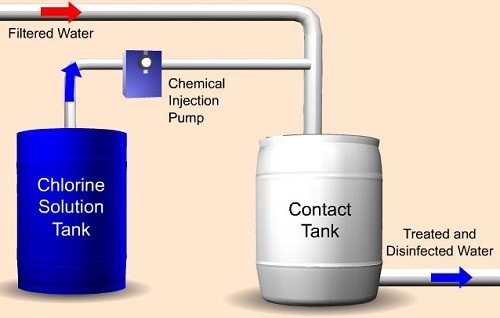When high quality water is required, such as drinking water, household water or livestock watering, disinfection is an essential barrier. Disinfection kills disease-causing organisms. Disinfection is usually the last barrier in municipal water treatment. Continual water testing is always necessary to ensure the disinfection process is working effectively.
Pathogenic organisms cause disease. The most common pathogenic organisms in water are:
- bacteria: a bacterium can be 1 micrometre
- viruses: a virus can be 0.05 to 0.1 micrometre
- protozoan parasites: Giardia can be 6 to 12 micrometres, Cryptosporidium can be 2 to 5 micrometres
A human hair is about 60 micrometres in diameter. This is visible to the naked eye. These organisms are small enough to easily pass through most water treatment systems. This is why disinfection is so important.

Description of the above image
human hair and different pathogens
- human hair is about 60 micrometres in diameter
- a bacterium can be 1 micrometre
- a virus can be 0.05 to 0.1 micrometre
- Giardia can be 6 to 12 micrometres
- Cryptosporidium can be 2 to 5 micrometres
Disinfection
Chlorination
Chlorine disinfection works by killing disease-causing microorganisms. Chlorination is most effective on water pre-treated with coagulation and filtration. Chlorine doses and contact times must be designed to suit the water and require regular monitoring.

Description of the above image
Diagram shows a pipe carrying filtered water and a chlorine solution tank with a chemical injection pump. The filtered water mixes with the chlorine solution in a contact tank. The treated and disinfected water is piped out of the contact tank.
A dose of chlorine is designed to be in contact with disease-causing organisms long enough to kill the organisms. Chlorination is not effective for parasites such as Giardia and Cryptosporidia, because they have a tough protective layer that resists chlorine. This is why rural households may want to use a polishing device such as a reverse osmosis unit or a distiller. Chlorine levels at drinking water taps should be detectable. Usually the level is designed to be 0.5 mg/L total chlorine or 0.1 mg/L free chlorine.
This residual is desirable for keeping pipes clean, stopping microorganisms from re-contaminating the water, and for monitoring the chlorine process.
Chlorine disinfection will not work if the water is too dirty. Particles will protect the disease-causing organisms from the chlorine and they will remain alive in the water, and can cause disease.
Ultraviolet disinfection
Ultraviolet (UV) light disinfection works by exposing disease-causing microorganisms to intense ultraviolet light. The ultraviolet light alters the DNA of the microorganisms, making them unable to reproduce and cause disease. UV disinfection is effective for bacteria, viruses and parasites.

Description of the above image
Diagram shows a UV disinfection unit. A powerful UV light encased in a quartz sleeve is in the centre of a disinfection chamber. Water enters the chamber at the inlet on one end and is exposed to the UV light as it flows through and out the other end. The outlet water is disinfected.
UV disinfection is most effective on water pre-treated with coagulation and filtration.
UV bulbs require replacement on a regular basis. Ultraviolet light disinfection will not work if the water is too dirty or coloured. Particles or colour will protect the disease-causing organisms from the UV rays and they will remain infectious.
Even after improved pretreatment, poorly filtered water may impair the ultraviolet process. If organic material or mineral deposits cover the glass sleeve, then the micro-organisms will not receive the correct light intensity; they will reproduce and cause disease.
With UV disinfection, pretreatment may need to include water softening and/or iron removal processes to avoid coating the bulb. The protective glass sleeve must be regularly cleaned or replaced if damaged by poor quality water.